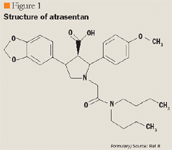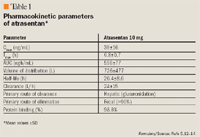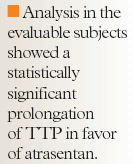- Safety & Recalls
- Regulatory Updates
- Drug Coverage
- COPD
- Cardiovascular
- Obstetrics-Gynecology & Women's Health
- Ophthalmology
- Clinical Pharmacology
- Pediatrics
- Urology
- Pharmacy
- Idiopathic Pulmonary Fibrosis
- Diabetes and Endocrinology
- Allergy, Immunology, and ENT
- Musculoskeletal/Rheumatology
- Respiratory
- Psychiatry and Behavioral Health
- Dermatology
- Oncology
Atrasentan: A novel selective endothelin-A receptor antagonist
Accumulating data have demonstrated that the endothelin axis plays a role in the progression of many malignancies. Endothelin-1, which is produced by prostate cancer cells, can stimulate new bone formation. It can also act synergistically with a number of growth factors promoting cancer cells growth and proliferation. Over-expression of endothelin-1 and diminished capacity for its clearance have been seen in prostate cancer cell lines. The highest concentration of endothelin-1 is found in patients with hormone refractory metastatic disease. Atrasentan (Xinlay, Abbott) is a member of a new class of drugs called the selective endothelin-A receptor antagonists (SERAs). The safety and efficacy of atrasentan in hormone refractory prostate cancer (HRPC) have been evaluated in several clinical trials. Atrasentan demonstrated some efficacy in delaying the progression of disease and improving patients' quality of life while having an acceptable safety profile. An NDA for atrasentan was submitted in December 2004 for..
Abstract
Accumulating data have demonstrated that the endothelin axis plays a role in the progression of many malignancies. Endothelin-1, which is produced by prostate cancer cells, can stimulate new bone formation. It can also act synergistically with a number of growth factors promoting cancer cells growth and proliferation. Over-expression of endothelin-1 and diminished capacity for its clearance have been seen in prostate cancer cell lines. The highest concentration of endothelin-1 is found in patients with hormone refractory metastatic disease. Atrasentan (Xinlay, Abbott) is a member of a new class of drugs called the selective endothelin-A receptor antagonists (SERAs). The safety and efficacy of atrasentan in hormone refractory prostate cancer (HRPC) have been evaluated in several clinical trials. Atrasentan demonstrated some efficacy in delaying the progression of disease and improving patients' quality of life while having an acceptable safety profile. An NDA for atrasentan was submitted in December 2004 for the treatment of patients with HRPC metastatic to bone. A response from FDA is anticipated later this year. (Formulary. 2005;40:376–381.)
Prostate cancer is the most commonly diagnosed non-skin cancer in the United States. An estimated 232,000 US men will be diagnosed with prostate cancer this year.1 Prostate cancer is also the second leading cause of cancer death in men, exceeded only by lung cancer, with an estimated 30,000 deaths from the disease in 2005.1 Androgen-deprivation therapy, usually with combined androgen blockade, is standard initial treatment for advanced prostate cancer. Unfortunately, patients ultimately become unresponsive to androgen blockade and are classified as having hormone refractory prostate cancer (HRPC). Despite treatment, the prognosis of HRPC remains poor.2
Atrasentan (Xinlay [pronounced Zin–lay], Abbott) is a selective endothelin-A receptor antagonist developed for the treatment of various malignancies. Activity in patients with prostate cancer has been demonstrated in placebo-controlled trials. Atrasentan is currently under review by FDA for the treatment of patients with HRPC metastatic to bone; a response is anticipated later this year.
CHEMISTRY AND PHARMACOLOGY

PHARMACOKINETICS

CLINICAL TRIALS
The efficacy of atrasentan in patients with metastatic HRPC was demonstrated in 2 randomized, double-blind, placebo-controlled studies, M96-594 and M00-211. In M96-594, a total of 288 men with asymptomatic metastatic hormone refractory prostate cancer were randomized to receive atrasentan 2.5 (n=95) or 10 mg (n= 89) or placebo (N=104) orally, once daily.15 Almost all patients had a history of prior therapies and patients in the placebo arm were more heavily pretreated. The primary efficacy end point was time to disease progression. Secondary efficacy end points included prostate-specific antigen (PSA) progression, bone scan changes, and changes in bone and tumor markers. Quality of life data and quality of life adjusted time to progression (TTP) were also evaluated. Median time to disease progression was 178, 183, and 137 days for the atrasentan 2.5-mg, atrasentan 10-mg, and placebo groups, respectively. The difference was not statistically significant in the in the intent-to-treat (ITT) analysis. Analysis in the evaluable subjects showed a statistically significant prolongation of TTP in favor of atrasentan. Median time to PSA progression was also significant in favor of atrasentan 10 mg, but not 2.5 mg. In this study, atrasentan significantly attenuated the increase in biomarkers related to disease progression.16

A meta-analysis of M96-594 and M00-211 was conducted and presented at the American Society of Clinical Oncology (ASCO) annual meeting in 2005.18 The analysis of these studies was performed to more precisely define the clinical benefit of atrasentan at the 10-mg dose. A total of 1,002 patients were randomized to either atrasentan 10 mg (n=497) or placebo (n=505) in the 2 studies. Atrasentan 10 mg resulted in a statistically significant delay in time to disease progression compared with placebo. Patients treated with atrasentan 10 mg were 14% less likely to experience disease progression, had an 18% lower likelihood of experiencing bone pain, and had a 22% lower likelihood of experiencing PSA progression. However, this analysis was criticized because the 2 studies had different treatment populations and designs. Also, the definition of the primary end point, time to disease progression, was substantially different in each study.
The efficacy and safety of atrasentan in symptomatic HRPC were also evaluated. A total of 131 men with metastatic HRPC with disease-related pain requiring opioid analgesics were randomized to 1 of the 3 study groups: 43 patients were randomized to the placebo arm, 40 were randomized to the 2.5-mg atrasentan arm, and 48 were randomized to the 10-mg atrasentan arm.10,18 The primary end point was pain relief and change in biochemical marker activity. There was no statistically significant difference in response rates for the primary end point. In the 10-mg atrasentan group, however, a trend toward improvement in pain without increased analgesic consumption was seen.10

ADVERSE EVENTS

DRUG INTERACTIONS
No significant drug-drug interactions were observed when atrasentan was administered in combination with a variety of medications, including NSAIDs, LHRH analogs, and opioids.17 The severe adverse events that limited dose escalation in atrasentan dose-finding studies were hypotension and hyponatremia, which may be explained by the vasoactive changes induced by atrasentan.12 Blood pressure should be monitored in subjects receiving atrasentan, and adjustment of concomitant antihypertensives may be necessary. The pharmacokinetics of atrasentan were evaluated with a CYP3A inhibitor (ketoconazole) and inducer (rifampin). In addition, the effect of atrasentan on the drug transport of P-glycoprotein was studied. No drug interactions were identified.19,20,21,22
DOSING AND ADMINISTRATION
Atrasentan doses of 2.5 and 10 mg orally once daily were used in clinical trials. The 10-mg dose will be the likely approved dose considering the results of the meta-analysis presented at the ASCO 2005 annual meeting. Therapy should continue until disease progression or unacceptable toxicity occurs. There are no published data on dose reductions or modifications.
Dr Abdelghany is Coordinator, Investigational Drug Service, Yale-New Haven Hospital, New Haven, Conn. He can be reached at osama.abdelghany@ynhh.org
.
REFERENCES
1. American Cancer Society. Cancer Facts and Figures 2005. Atlanta, Ga: American Cancer Society; 2005.
2. Bhandari MS, Petrylak DP, Hussain M. Clinical trials in metastatic prostate cancer-has there been real progress in the past decade? Eur J Cancer. 2005;41(6):941–953.
4. Wessale JL, Adler AL, Novosad EI, et al. Pharmacology of endothelin receptor antagonists ABT-627, ABT-546, A-182086 and A-192621: ex vivo and in vivo studies. Clin Sci. 2002;103: 112S–117S.
5. Ryan CW, Vogelzang NJ, Vokes EE, et al. Dose-ranging study of the safety and pharmacokinetics of atrasentan in patients with refractory malignancies. Clin Cancer Res. 2004;10:4406–4411.
6. Smith MR, Nelson JB. Future therapies in hormone-refractory prostate cancer. Urology. 2005; 65(Suppl 5):9–17.
7. Nelson J, Bagnato A, Battistini B, et al. The endothelin axis: emerging role in cancer. Nat Rev Cancer. 2003;3:110–116.
8. Nelson JB. Endothelin receptor antagonists. World J Urol. 2005;23:19–27.
9. Guise TA, Yin JJ, Mohammad KS. Role of endothelin-1 in osteoblastic bone metastases. Cancer. 2003;97(3 suppl.):779–784.
10. Nelson JB. Endothelin inhibition: novel therapy for prostate cancer. J Urol. 2003;170(Suppl 6 Pt 2):S65–S68.
11. Yin JJ, Mohammad KS, Käkönen SM, et al. A causal role for endothelin-1 in the pathogenesis of osteoblastic bone metastases. Proc Natl Acad Sci USA. 2003;100: 10,954–10,959.
12. Carducci MA, Nelson JB, Bowling MK, et al. Atrasentan, an endothelin-receptor antagonist for refractory adenocarcinomas: safety and pharmacokinetics. J Clin Oncol. 2002;20:2171–2180. Erratum in: J Clin Oncol. 2003;21:2449.
13. Samara E, Dutta S, Cao G, et al. Single-dose pharmacokinetics of atrasentan, an endothelin-A receptor antagonist. J Clin Pharmacol. 2001;41:397–403.
14. Bernard A. Zonnenberg, Gerard Groenewegen, et al. Phase I dose-escalation study of the safety and pharmacokinetics of atrasentan: an endothelin receptor antagonist for refractory prostate cancer. Clin Cancer Res. 2003;9:2965–2972.
15. Carducci MA, Padley RJ, Breul J, et al. Effect of endothelin-A receptor blockade with atrasentan on tumor progression in men with hormone-refractory prostate cancer: a randomized, phase II, placebo-controlled trial. J Clin Oncol. 2003;21: 679–689.
16. Nelson JB, Nabulsi AA, Vogelzang NJ, et al. Suppression of prostate cancer induced bone remodeling by the endothelin receptor A antagonist atrasentan. J Urol. 2003;169:11,439.
17. Xinlay (atrasentan hydrochloride). Oncologic Drugs Advisory Committee Briefing Document. September 13, 2005.
18. Vogelzang NJ, Nelson JB, Schulman CC, et al. Meta-analysis of clinical trials of atrasentan 10 mg in metastatic hormone-refractory prostate cancer [abstract]. In: Proceedings of the 41st Annual Meeting of the American Society of Clinical Oncology; May 13–May 17, 2005; Orlando, Fla. Abstract 4563.
19. Klein CE, Schroeder MC, Facey I, et al. Effect of atrasentan (ABT-627, ATN) on the pharmacokinetics (PK) of fexofenadine (FEX). J Clin Oncology. 2004;22(14S):4723.
20. Peng JZ, Doan T, Burt D, et al. Effect of atrasentan (ABT-627, ATN) on the pharmacokinetics (PK) of midazolam (MDZ). J Clin Oncology. 2004;22(14S):4725.
21. Zhu T, Andre A, Facey I, et al. Effect of ketoconazole (KET) on the pharmacokinetics (PK) of atrasentan (ABT-627, ATN). J Clin Oncology. 2004;22(14S):4727.
22. Xiong X, Jankowski J, Ashbrenner E, et al. Effect of rifampin (RIF) on the pharmacokinetics (PK) of atrasentan (ABT-627, ATN). J Clin Oncology. 2004;22(14S):4728.
23. Petrylak DP, Tangen C, Hussain MHA, et al. Docetaxel and estramustine compared with mitoxantrone and prednisone for advanced refractory prostate cancer. N Engl J Med. 2004;351: 1513–1520.
24. Tannock IF, de Wit R, Berry WR, et al. Docetaxel plus prednisone or mitoxantrone plus prednisone for advanced prostate cancer. N Engl J Med. 2004;351(15):1502–1512.
In each issue, the "Focus on" feature reviews a newly approved or investigational drug of interest to pharmacy and therapeutics committee members. The column is coordinated by Robert A. Quercia, MS, RPh, director of Drug Information Services at Hartford Hospital in Hartford, Conn, and adjunct associate professor, University of Connecticut School of Pharmacy, Storrs, Conn; and by Craig I. Coleman, PharmD, assistant professor of pharmacy practice, University of Connecticut School of Pharmacy, and director, Pharmacoeconomics and Outcomes Studies Group, Hartford Hospital.
EDITORS' NOTE: The clinical information provided in "Focus on" articles is as current as possible. Due to regularly emerging data on developmental or newly approved drug therapies, articles include information published or presented and available to the author up until the time of the manuscript submission.
Employers Face Barriers With Adopting Biosimilars
March 1st 2022Despite the promise of savings billions of dollars in the United States, adoption of biosimilars has been slow. A roundtable discussion among employers highlighted some of the barriers, including formulary design and drug pricing and rebates.
